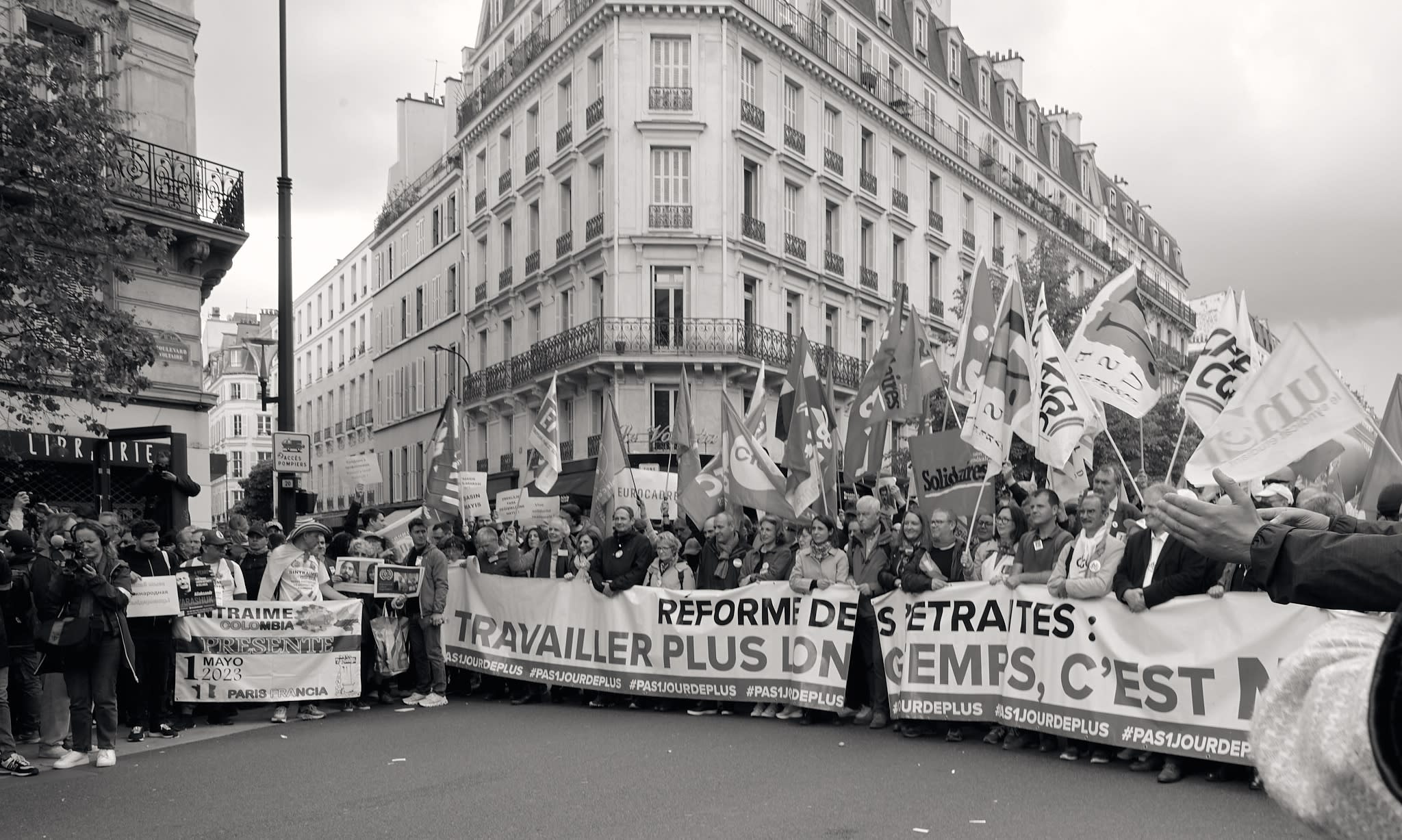
The Anatomy of a Resistance;
The 2023 Pension Reform in France
Written and Photographed by Gulgun Gunal
The year 2023 in France began with the government's proposal for a Pension Reform, sparking a large-scale social movement involving millions of people. The government led by President Emmanuel Macron and Prime Minister Élisabeth Borne announced plans to raise the retirement age from 62 to 64 and increase the minimum contribution period to 43 years. This proposal met with widespread public backlash, leading to mass protests across the country.
The year was not only significant for the Pension Reform but also marked an important political turning point in France. During the presidential elections, Emmanuel Macron was reelected, playing a decisive role in the advancement of the Pension Reform and shaping public reactions. The elections significantly influenced the general attitude towards the reform and the public's response, making the Macron administration's decision to support the reform policies a fundamental element affecting the intensity and nature of the social movements.
We will examine the announcement of this Pension Reform and the initial public reactions in the following sections.

The Beginning and Development of the Movement
The initial major response against the government's Reform plans started early in 2023. Eight major unions - CFDT, CGT, FO, UNSA, CGC, CFTC, Solidaires, and FSU - formed a coalition, calling for protests and strikes. This mobilized workers to temporarily stop work and collectively take to the streets in opposition to the government's plans. The movement, which started on January 19, reached its peak with actions across 300 cities on 13 different days. The number of participants surpassed the records set in previous years, 1995 and 2010.[1]
Following this initial stage, the role of unions in the development of the movement gained importance. The unions adopted various strategies to counter the government's Reform plans and mobilize widespread social support. This effort encouraged broad participation from different sections of society, making the movement felt not just on the streets, but also in workplaces. This process will be explored in more detail in the section 'The Role of Unions and Public Reaction.'

Key Dates and Participation Numbers
January 19, 2023: The first major day of action. About 1.12 million people participated in demonstrations in 200 cities, with union estimates reaching up to two million.[2] This represented approximately 1.65% of France's population.
January 31, 2023: Participation increased, with the Ministry of the Interior reporting 1.27 million and unions between 2.5 and 2.8 million participants, about 1.87% of the population.[3]
March 7, 2023: Police sources reported about 1.28 million participants, while CGT estimated around 3.5 million, representing about 1.89% of the population.[4] This indicated the wide interest and participation of the French society in these events.
March 15, 2023: A critical date when the Reform was adopted without parliamentary voting, using Article 49.3 of the Constitution.[5]
April 13, 2023: Significant protests continued, indicating the ongoing resistance and public opposition to the Reform.[6]
June 6, 2023: The Ministry of the Interior and union sources reported participant numbers ranging from 300,000 to 900,000, representing about 1.33% of the population. [7]

The Role of Unions and Public Reaction
In the resistance against the Pension Reform in France, unions played a central role. They developed a broad-based strategy to oppose the government's Reform plans, escalating their actions when negotiations stalled. They initiated intermittent blockades at strategic points like ports, roads, bridges, refineries, and logistics platforms, creating pressure in critical areas affecting the country's economic and social life. These actions were supported by approximately two-thirds of the French public, reflecting deep social solidarity and a collective response against government policies.[8]
The reasons for the lack of progress in negotiations with the government were multifaceted. Political stalemates, the government's insistence on the Reform, and discrepancies between the government and union demands all contributed to the deadlock in negotiations. The unions' actions had significant socio-economic impacts on France. Strikes and blockades caused production losses, supply chain disruptions, and service interruptions, directly affecting daily life and highlighting the concrete cost of the Reform.
From the perspective of union leaders and members, these actions represented not just an economic struggle but also a fight for democratic values and workers' rights. Therefore, the actions resonated not only in workplaces but also across broader sections of society.


Counter Views: Supporters of the French Pension Reform
Public and Union Support: [9]During the pension reform process, some union leaders and a significant portion of the public opinion expressed the necessity for the reform and the need to take measures for a more balanced retirement system. For instance, CFDT leader Laurent Berger emphasized that age should no longer be the sole determining factor in the retirement system and that other factors should be taken into consideration.[10]
Increase in Life Expectancy and Active Life Duration: The defenders of the pension reform generally focus on the increase in life expectancy (which means an increase in the average duration of human life) and the extension of years lived in good health. They argue that the reform must adapt to these changes and that the retirement system needs to be reorganized according to these new realities.
International Comparisons: The retirement system in France has unique characteristics compared to other European countries. For example, unlike other countries, the French retirement system is entirely funded by the state and not by private pension funds. This creates an additional burden on public spending, and the defenders of the reform assert that these structural differences need to be addressed.
Demographic Changes and Budgetary Balance: The defenders of the pension reform highlight France's aging population and the long-term financial sustainability of the retirement system. Specifically, the increase in the elderly population due to the "baby-boom" of 1945-1948 puts pressure on public finances. Proponents of the reform argue that these demographic changes must be taken into account. The 2023 pension reform in France, though it has sparked controversy among the public, is considered by the government and some economists as a necessary step in the face of demographic changes and economic sustainability. This reform plans to raise the retirement age from 62 to 64 and extend the minimum contribution period to 43 years.
Adoption of the Reform and the Democratic Crisis
The Reform was adopted on March 16, 2023, without a parliamentary vote, deepening a democratic crisis and leading to daily demonstrations.[11] The government's move caused significant anger among unions and the general public.[12], [13],[14]

Why Did the French Government Adopt the Pension Reform Despite Widespread Opposition?
The French government's decision to implement the Pension Reform, despite significant social opposition, was influenced by both economic and political factors. The rising public debt and aging population of France raised serious concerns about the sustainability of the pension system, necessitating the reform. Politically, President Emmanuel Macron's personal determination and political goals were decisive in persisting with the reform despite widespread opposition and public backlash. This decision is expected to shape both France's economic future and Macron's political legacy.[15], [16]
Police Brutality and International Concerns
During the protests, especially in major cities, police brutality and the use of excessive force were criticized. These harsh interventions caused significant concern and anger in society, deepening general dissatisfaction with security policies and human rights, and raising alarm among international organizations.[17], [18]








Historical and International Context of the Reform
France's pension system, entirely based on a distribution model, is unique compared to other European countries. The Reform, justified by increasing life expectancy, was critically assessed in the context of past pension reforms in France and similar reforms in Europe.[19], [20]
Conclusion: The Power and Importance of Social Movements
The social movements against the 2023 French pension reform not only signal a new era in French politics but also mark the beginning of a new chapter in broad democratic struggles. These movements showcase the power of civil society to influence government policies and effect social change. The resistance to the Reform process has not only prompted a reevaluation of current policies but also has the potential to guide future policy-making processes.
Check out the gallery: https://www.gulgun.fr/en/reportage/contre-la-r-forme-des-retraites-/


[1] Libération
[2] Le Monde
[3] Le Monde
[4] Le Monde
[5] Le Monde
[6] Le Monde
[7] Le Monde
[8] Libération
[9] France Inter
[10] OFCE
[11] Libération
[12] Le Monde
[13] Public Sénat
[14] France 24
[15] La Presse+
[16] La Dépêche
[17] France 24
[18] Libérarion
[19] France Inter
[20] OFCE